The number of children living in poverty has swelled over the past three decades in fast-growing, ethnically diverse states such as Texas, Arizona and Nevada as the nation's population center shifts south and west, a report Monday on childhood well-being shows.
The annual Kids Count report from the Annie E. Casey Foundation found that 18% of the nation's children live in poverty, down from the Great Recession.
But the same advances weren't seen in the Southwest, where many children are Native Americans, Latinos and immigrants who have long faced disadvantages.

In this photo taken Friday, June 14, 2019, volunteers including 60-year-old Laura Orchard pick up food packages to deliver to homebound families and dependent children in Santa Fe, N.M., at the headquarters for Kitchen Angels. An annual report on childhood well-being from the Annie E. Casey Foundation ranks New Mexico last among 50 states that includes measures of poverty, health care, education and family support. The number of children living in poverty has swelled over the past three decades in fast-growing, ethnically diverse states such as Texas, Arizona and Nevada as the nation's population center shifts south and west. (AP PhotoMorgan Lee)
"The nation's racial inequities remain deep, systemic and stubbornly persistent," said the annual Kids Count report from the Annie E. Casey Foundation.
"Thirteen million children continue to live in poverty in spite of the economic growth that we have seen recently, and low unemployment," said Leslie Boissiere, a vice president at the foundation.
"In those border states, it's as many as one in five. So you're seeing a higher rate of poverty among children in those states."
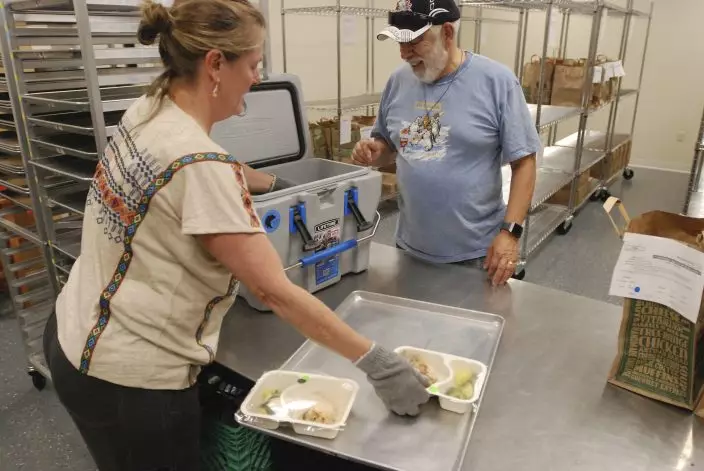
In this photo taken Friday, June 14, 2019, volunteers including retired accountant Ralph Nava, right, 69, pick up food packages to deliver to homebound families and dependent children in Santa Fe, N.M., at the headquarters for Kitchen Angels. An annual report on childhood well-being from the Annie E. Casey Foundation ranks New Mexico last among 50 states that includes measures of poverty, health care, education and family support. The number of children living in poverty has swelled over the past three decades in fast-growing, ethnically diverse states such as Texas, Arizona and Nevada as the nation's population center shifts south and west. (AP PhotoMorgan Lee)
The share of children without health insurance increased slightly in 2017, the most recent year studied, but remains near an all-time low at 5%. That was attributed in large part to state Medicaid programs and provisions of the Affordable Care Act.
Since 1990, however, the national rate of childhood poverty has remained unchanged.
The report measured 16 indicators of childhood well-being, from the rate of low birthweights and teen pregnancy to third-grade reading abilities and the prevalence of single-parent families.

In this photo taken Friday, June 14, 2019, volunteers including 67-year-old consultant John Miller pick up food packages to deliver to homebound families and dependent children in Santa Fe, N.M., at the headquarters for Kitchen Angels. An annual report on childhood well-being from the Annie E. Casey Foundation ranks New Mexico last among 50 states that includes measures of poverty, health care, education and family support. The number of children living in poverty has swelled over the past three decades in fast-growing, ethnically diverse states such as Texas, Arizona and Nevada as the nation's population center shifts south and west. (AP PhotoMorgan Lee)
Texas' childhood population swelled by an additional 2.5 million since 1990. The number of children in poverty there increased from about 1.1 million to 1.5 million, according to the foundation. In Arizona, it rose by 60% to 332,000 children.
In Nevada, the number of impoverished children more than tripled to 125,000 since 1990.
Denise Tanata, executive director of the Children's Advocacy Alliance in Nevada, says the state's relative prosperity sets it apart from other states persistently near the bottom of the childhood well-being rankings, such as Mississippi and Alabama.
"Historically it's been a very old-West mentality: 'Pull yourself up by your bootstraps,'" Tanata said. "We tend to be low in almost every category when it comes to kids and to families. ... We haven't been able to keep up with the population growth and the changing needs."
Boissiere of the Casey Foundation said underlying causes of childhood financial stress differ from state to state.
In Texas, about 26% of children live in households where at least one parent struggles to find secure employment. In New Mexico, which ranked last in the survey, more than one in three children were in that situation.
A crisis in affordable housing weighs on families in California — where 43% of children are in families with a high housing cost burden that consumes more than 30% of pre-tax income. The state excels in other measures, with only 3% of children going without health insurance.
Nationwide, the share of children with at least one immigrant parent has doubled since 1990 to 26%, the report found.
Fifteen states with fastest growing child populations owe that growth mainly to an influx from other states along with birth and death rates — not international immigration, the foundation said.
VENICE, Italy (AP) — Under the gaze of the world’s media, the fragile lagoon city of Venice launches a pilot program Thursday to charge day-trippers a 5-euro (around $5.35) entry fee that authorities hope will discourage visitors from arriving on peak days and make the city more livable for its dwindling residents.
Signs advising arriving visitors of the new requirement for a test phase of 29 days through July have been erected outside the main train station and other points of arrival.
Some 200 stewards have been trained to politely walk anyone unaware of the fee through the process of downloading a QR code. A kiosk has been set up for those not equipped with a smartphone. Once past designated entry ports, officials will carry out random checks for QR codes that show the day-tripper tax has been paid or that the bearer is exempt.
Transgressors face fines 50 euros to 300 euros. The requirement applies only for people arriving between 8:30 a.m. and 4 p.m. Outside of those hours, access is free.
“We need to find a new balance between the tourists and residents,’’ said the city’s top tourism official, Simone Venturini. “We need to safeguard the spaces of the residents, of course, and we need to discourage the arrival of day-trippers on some particular days.”
Venice has long suffered under the pressure of over-tourism, but officials say that pre-pandemic estimates ranging from 25 million to 30 million visitors a year — including day-trippers — are not reliable and that the pilot project also aims to come up with more exact figures to help better manage the phenomenon.
By contrast, registered visitors spending the night last year numbered 4.6 million, according to city figures, down 16% from pre-pandemic highs.
Venturini said the city is strained when the number of day-trippers reaches 30,000 to 40,000. Its narrow alleyways are clogged with people and water taxis packed, making it difficult for residents to go about their business.
Not all residents, however, are persuaded of the efficacy of the new system in dissuading mass tourism, and say more attention needs to be paid to boosting the resident population and services they need.
Venice last year passed a telling milestone when the number of tourist beds exceeded for the first time the number of official residents, which is now below 50,000 in the historic center with its picturesque canals.
“Putting a ticket to enter a city will not decrease not even by one single unit the number of visitors that are coming,’’ said Tommaso Cacciari, an activist who organized a protest Thursday against the measure.
“You pay a ticket to take the metro, to go to a museum, an amusement park; you don’t pay a ticket to enter a city. This is the last symbolic step of a project of an idea of this municipal administration to kick residents out of Venice,” he said.
Venturini said about 6,000 people had already paid to download the QR code, and officials expect paid day-tripper arrivals Thursday to reach some 10,000.
More than 70,000 others have downloaded a QR code denoting an exemption, including to work in Venice or as a resident of the Veneto region. People staying in hotels in Venice, including in mainland districts like Marghera or Mestre, should also get a QR code attesting to their stay, which includes a hotel tax.
The tourist official says interest in Venice's pilot program has been keen from other places suffering from mass tourism, including other Italian art cities and cities abroad such as Barcelona and Amsterdam.
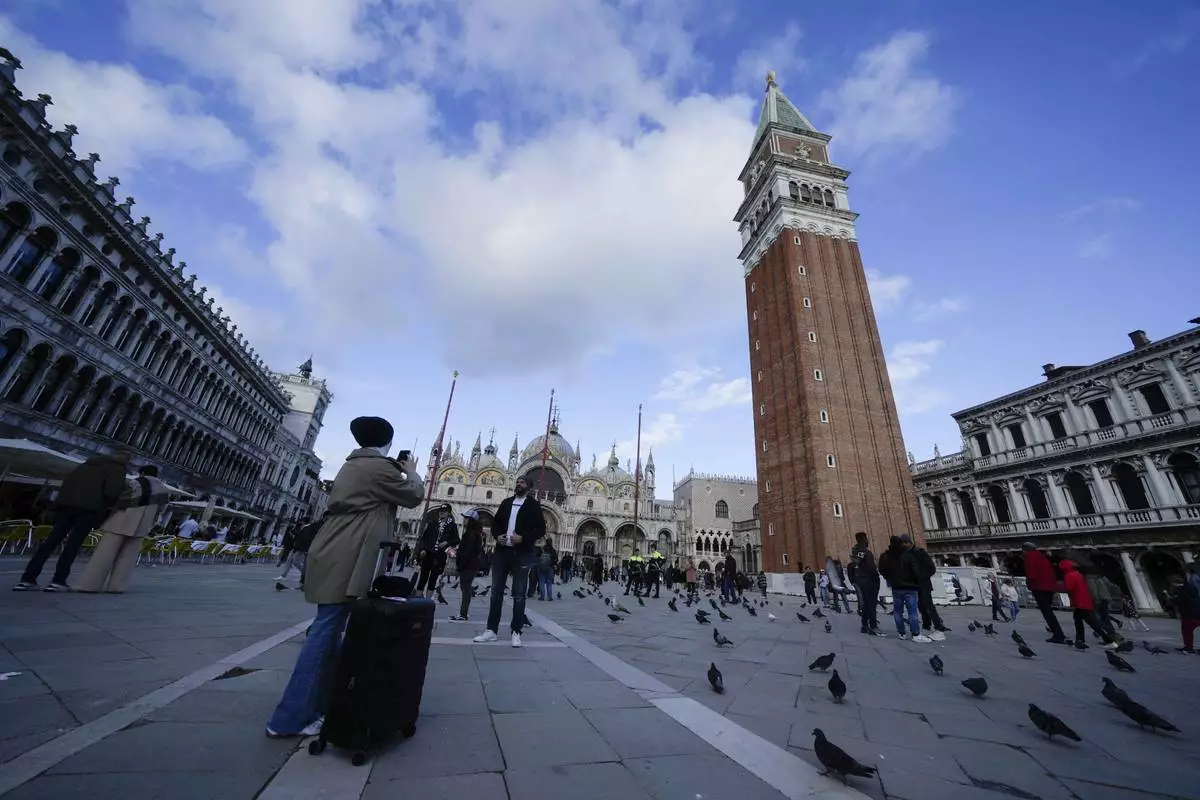
Tourists take pictures at the St. Mark square in Venice, Italy, Wednesday, April 24, 2024. The lagoon city of Venice begins a pilot program Thursday, April 25, 2024 to charge daytrippers a 5 euro entry fee that authorities hope will discourage tourists from arriving on peak days. Officials expect some 10,000 people will pay the fee to access the city on the first day, downloading a QR code to prove their payment. (AP Photo/Luca Bruno)
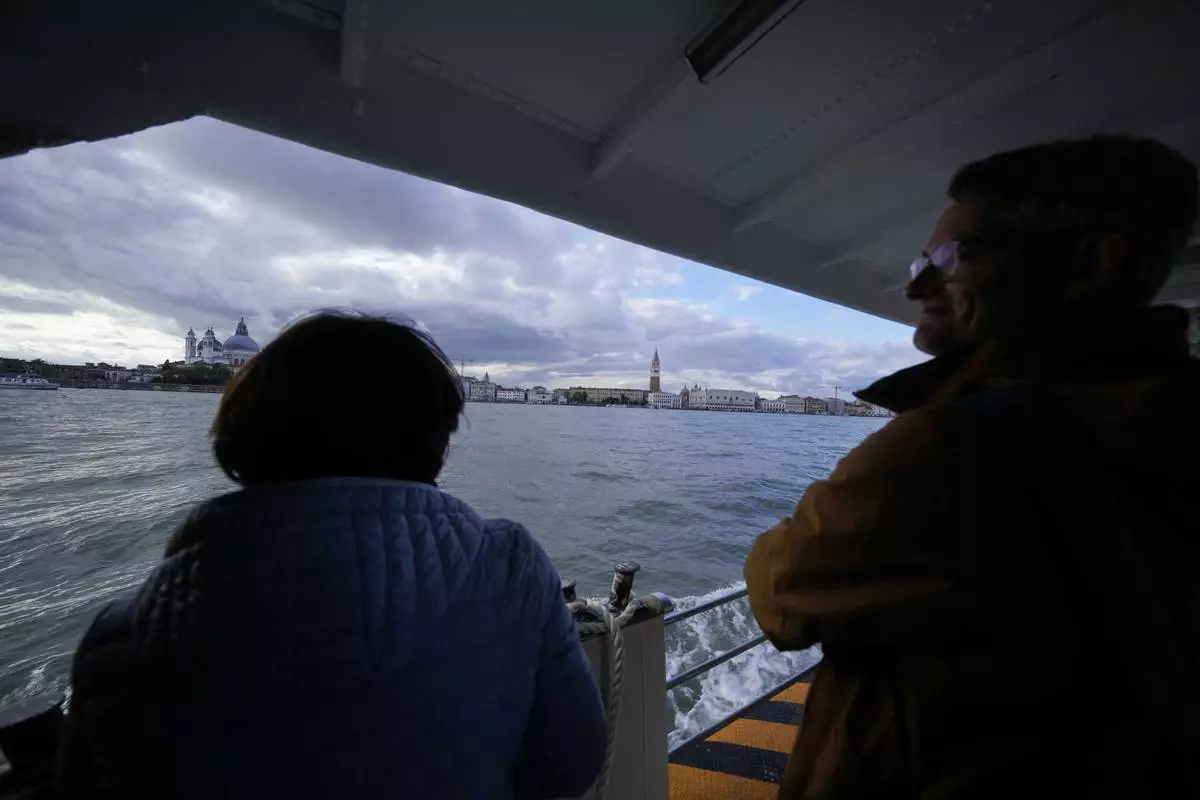
Tourists ride on a ferry boat in Venice, Italy, Wednesday, April 24, 2024. The lagoon city of Venice begins a pilot program Thursday, April 25, 2024 to charge daytrippers a 5 euro entry fee that authorities hope will discourage tourists from arriving on peak days. Officials expect some 10,000 people will pay the fee to access the city on the first day, downloading a QR code to prove their payment. (AP Photo/Luca Bruno)
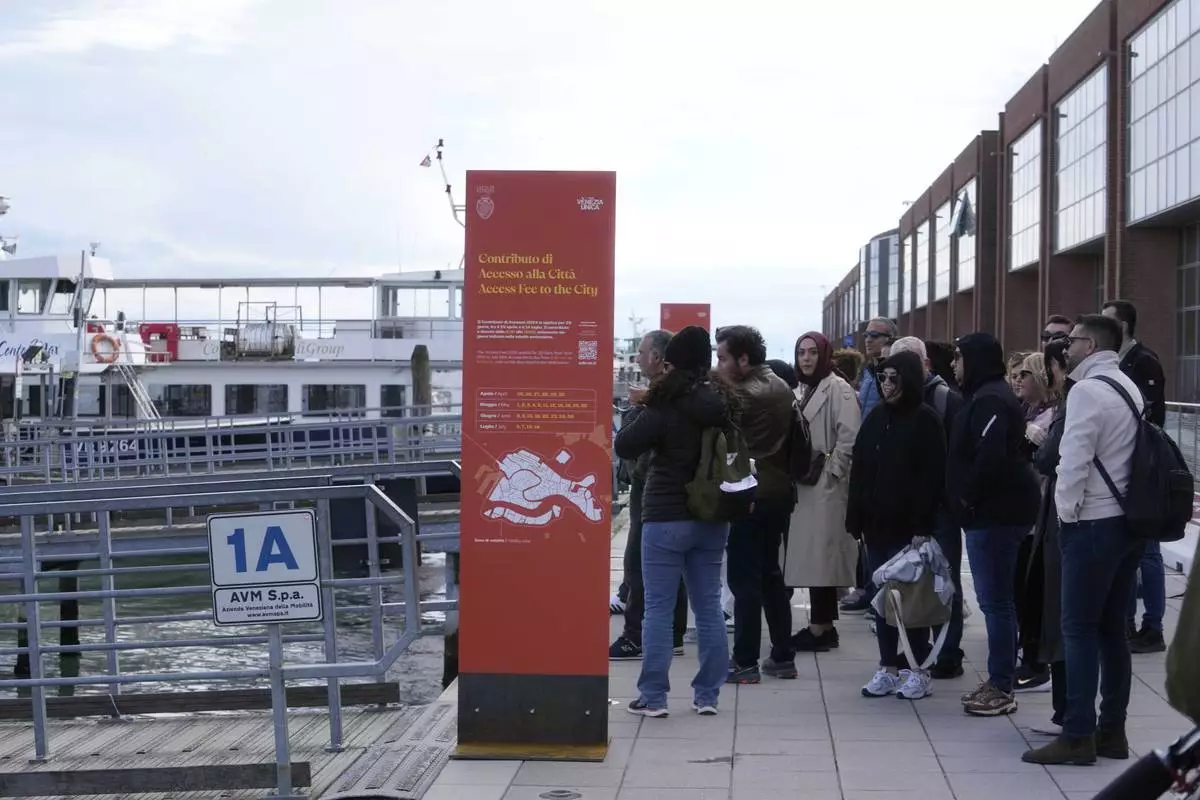
People stand in front of an information board explaining how to pay the tourist tax in Venice, Italy, Wednesday, April 24, 2024. The lagoon city of Venice begins a pilot program Thursday, April 25, 2024 to charge daytrippers a 5 euro entry fee that authorities hope will discourage tourists from arriving on peak days. Officials expect some 10,000 people will pay the fee to access the city on the first day, downloading a QR code to prove their payment. (AP Photo/Luca Bruno)
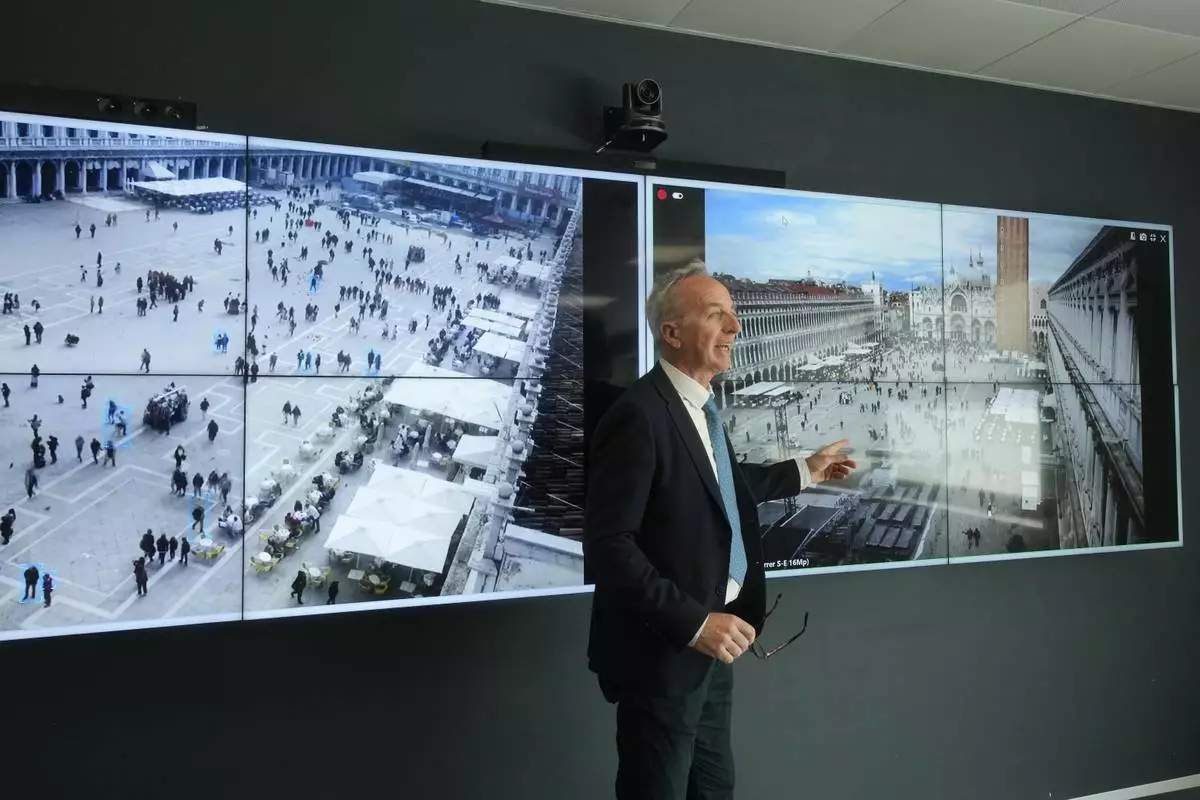
Marco Bettini, director of Venis Informatics System, gestures as he talks to reporters at the police Venice control room, in Venice, Italy, Wednesday, April 24, 2024. The lagoon city of Venice begins a pilot program Thursday, April 25, 2024 to charge daytrippers a 5 euro entry fee that authorities hope will discourage tourists from arriving on peak days. Officials expect some 10,000 people will pay the fee to access the city on the first day, downloading a QR code to prove their payment. (AP Photo/Luca Bruno)

Venice councillor Simone Venturini speaks with reporters in front of a tourist tax totem in Venice, Italy, Wednesday, April 24, 2024. The lagoon city of Venice begins a pilot program Thursday, April 25, 2024 to charge daytrippers a 5 euro entry fee that authorities hope will discourage tourists from arriving on peak days. Officials expect some 10,000 people will pay the fee to access the city on the first day, downloading a QR code to prove their payment. (AP Photo/Luca Bruno)
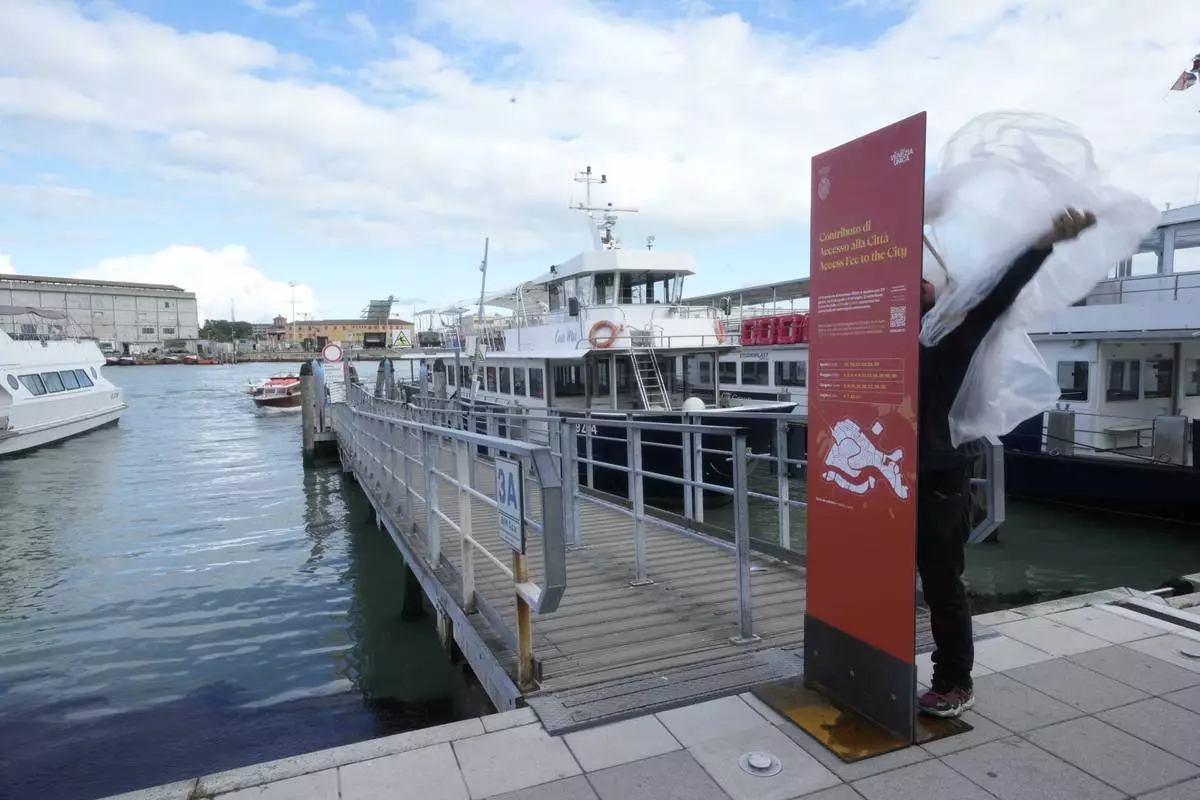
Workers prepare banner explaining how to pay the tourist tax in Venice, Italy, Wednesday, April 24, 2024. The lagoon city of Venice begins a pilot program Thursday, April 25, 2024 to charge daytrippers a 5 euro entry fee that authorities hope will discourage tourists from arriving on peak days. Officials expect some 10,000 people will pay the fee to access the city on the first day, downloading a QR code to prove their payment. (AP Photo/Luca Bruno)

Marco Bettini, director of Venis Informatics System, gestures as he explains the Venice density to reporters at the police Venice control room in Venice, Italy, Wednesday, April 24, 2024. The lagoon city of Venice begins a pilot program Thursday, April 25, 2024 to charge daytrippers a 5 euro entry fee that authorities hope will discourage tourists from arriving on peak days. Officials expect some 10,000 people will pay the fee to access the city on the first day, downloading a QR code to prove their payment. (AP Photo/Luca Bruno)
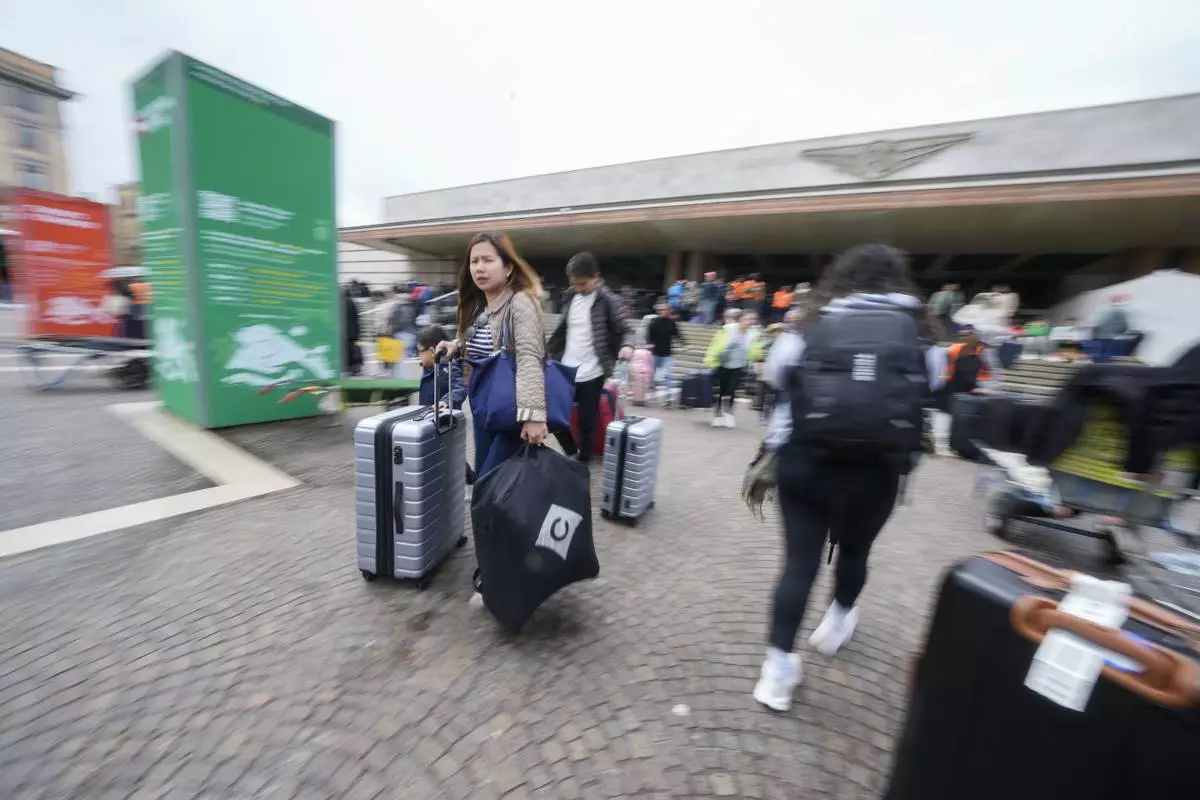
Tourists arrive at the main train station in Venice, Italy, Wednesday, April 24, 2024. The lagoon city of Venice begins a pilot program Thursday, April 25, 2024 to charge daytrippers a 5 euro entry fee that authorities hope will discourage tourists from arriving on peak days. Officials expect some 10,000 people will pay the fee to access the city on the first day, downloading a QR code to prove their payment. (AP Photo/Luca Bruno)
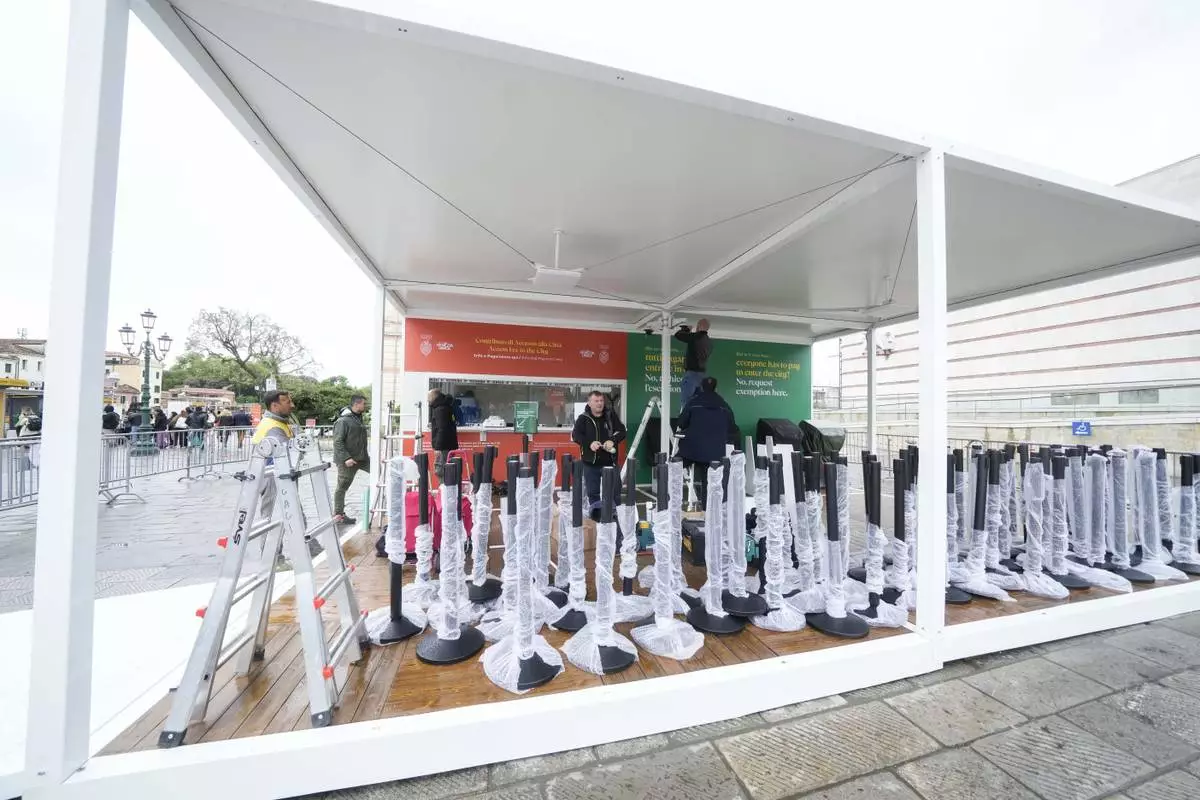
Workers prepare the tourist tax cashier desks outside the main train station in Venice, Italy, Wednesday, April 24, 2024. The lagoon city of Venice begins a pilot program Thursday, April 25, 2024 to charge daytrippers a 5 euro entry fee that authorities hope will discourage tourists from arriving on peak days. Officials expect some 10,000 people will pay the fee to access the city on the first day, downloading a QR code to prove their payment. (AP Photo/Luca Bruno)
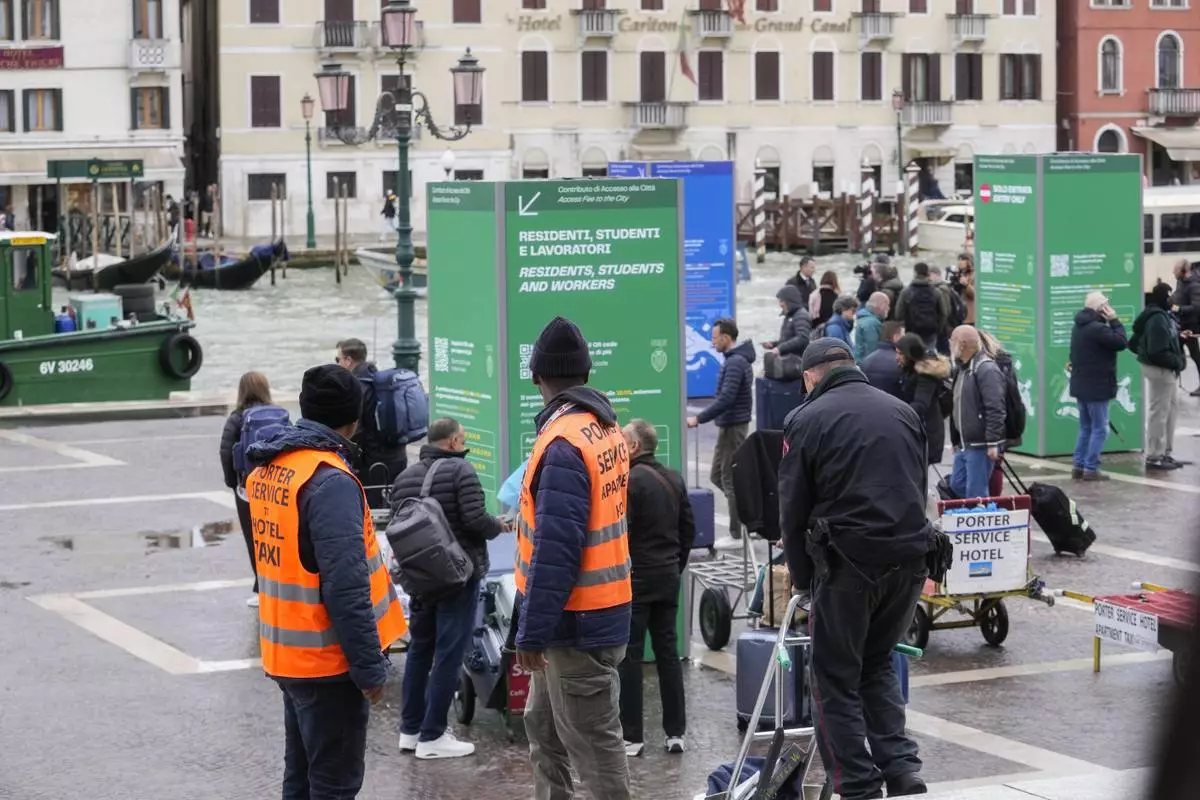
Porters wait for tourists outside the main train station in Venice, Italy, Wednesday, April 24, 2024. The lagoon city of Venice begins a pilot program Thursday, April 25, 2024 to charge daytrippers a 5 euro entry fee that authorities hope will discourage tourists from arriving on peak days. Officials expect some 10,000 people will pay the fee to access the city on the first day, downloading a QR code to prove their payment. (AP Photo/Luca Bruno)
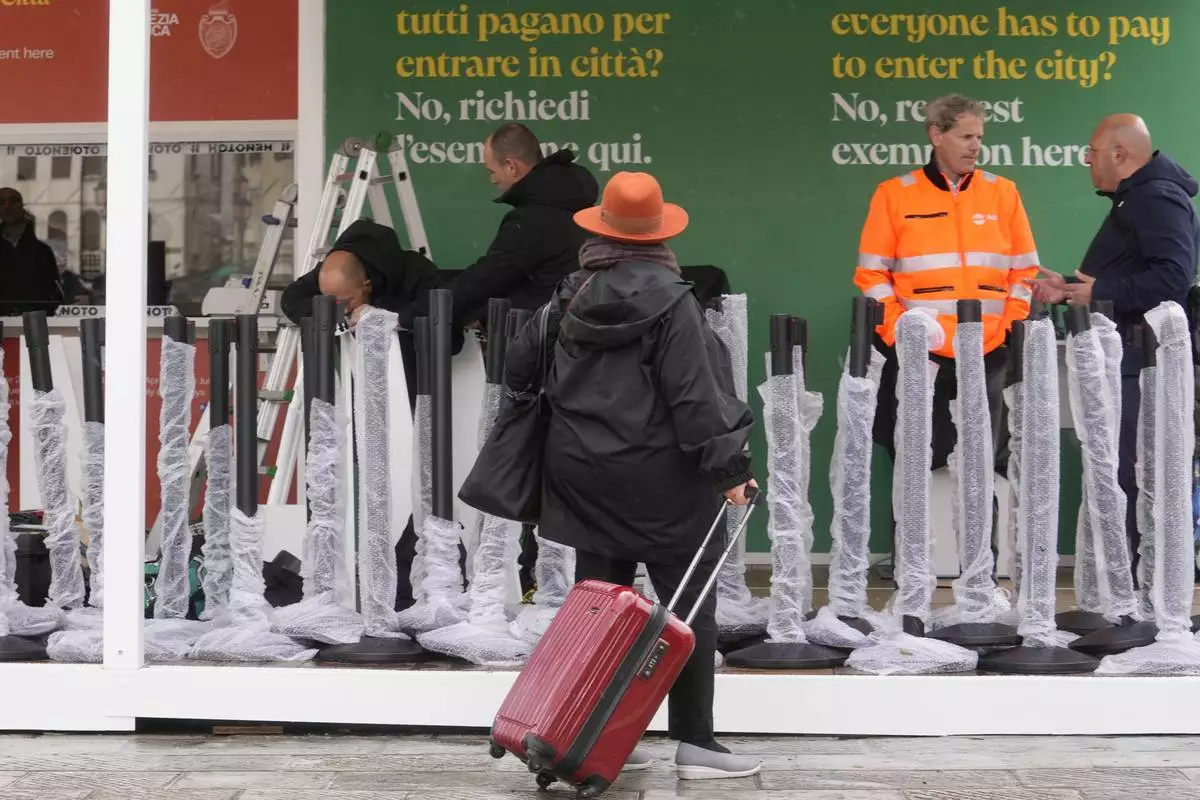
Workers prepare the tourist tax cashier desks outside the main train station in Venice, Italy, Wednesday, April 24, 2024. The lagoon city of Venice begins a pilot program Thursday, April 25, 2024 to charge daytrippers a 5 euro entry fee that authorities hope will discourage tourists from arriving on peak days. Officials expect some 10,000 people will pay the fee to access the city on the first day, downloading a QR code to prove their payment. (AP Photo/Luca Bruno)
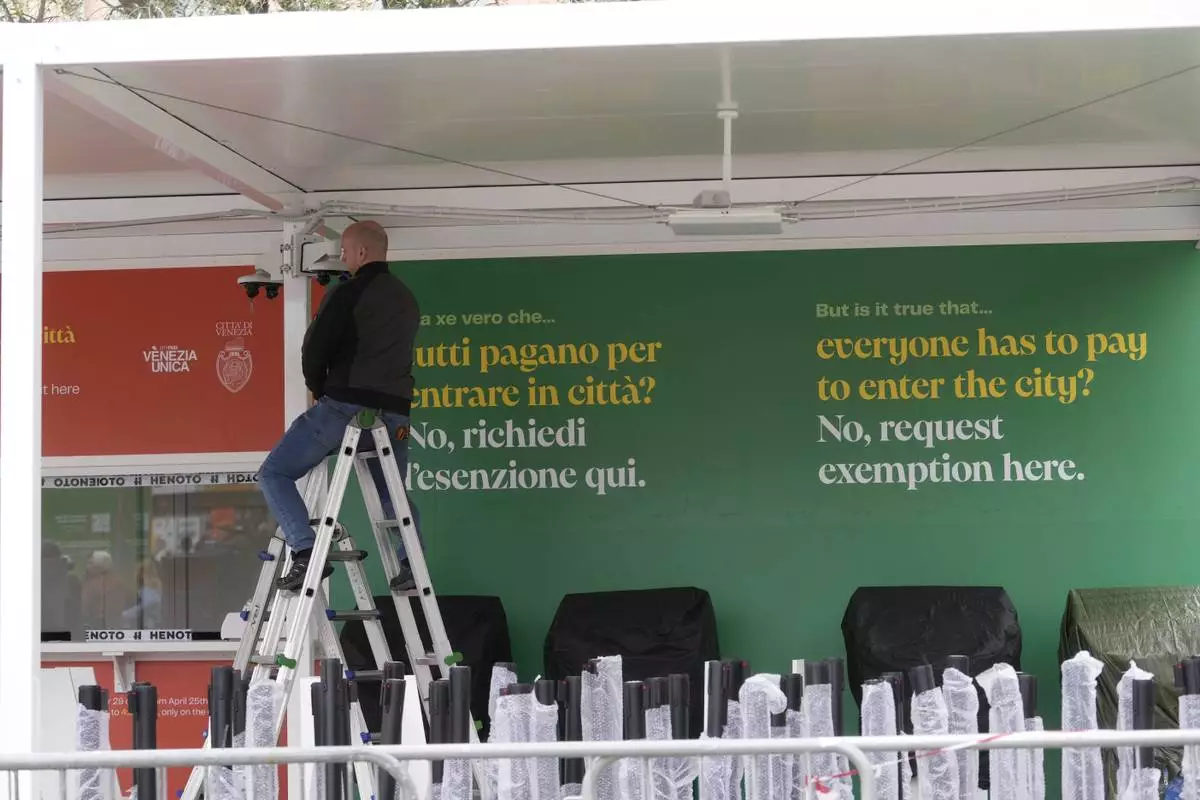
Workers prepare the tourist tax cashier desks outside the main train station in Venice, Italy, Wednesday, April 24, 2024. The lagoon city of Venice begins a pilot program Thursday, April 25, 2024 to charge daytrippers a 5 euro entry fee that authorities hope will discourage tourists from arriving on peak days. Officials expect some 10,000 people will pay the fee to access the city on the first day, downloading a QR code to prove their payment. (AP Photo/Luca Bruno)

Porters wait for tourists outside the main train station in Venice, Italy, Wednesday, April 24, 2024. The lagoon city of Venice begins a pilot program Thursday, April 25, 2024 to charge daytrippers a 5 euro entry fee that authorities hope will discourage tourists from arriving on peak days. Officials expect some 10,000 people will pay the fee to access the city on the first day, downloading a QR code to prove their payment. (AP Photo/Luca Bruno)
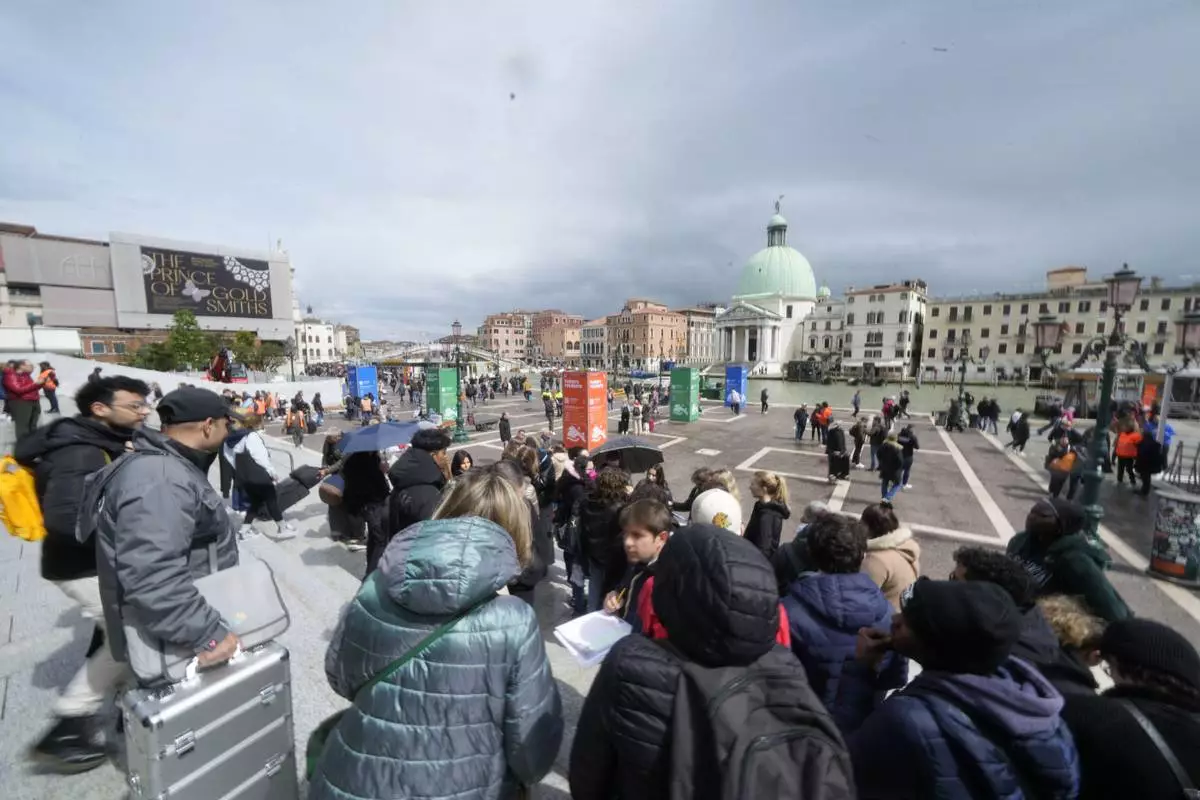
Tourists arrive outside the main train station in Venice, Italy, Wednesday, April 24, 2024. The lagoon city of Venice begins a pilot program Thursday, April 25, 2024 to charge daytrippers a 5 euro entry fee that authorities hope will discourage tourists from arriving on peak days. Officials expect some 10,000 people will pay the fee to access the city on the first day, downloading a QR code to prove their payment. (AP Photo/Luca Bruno)
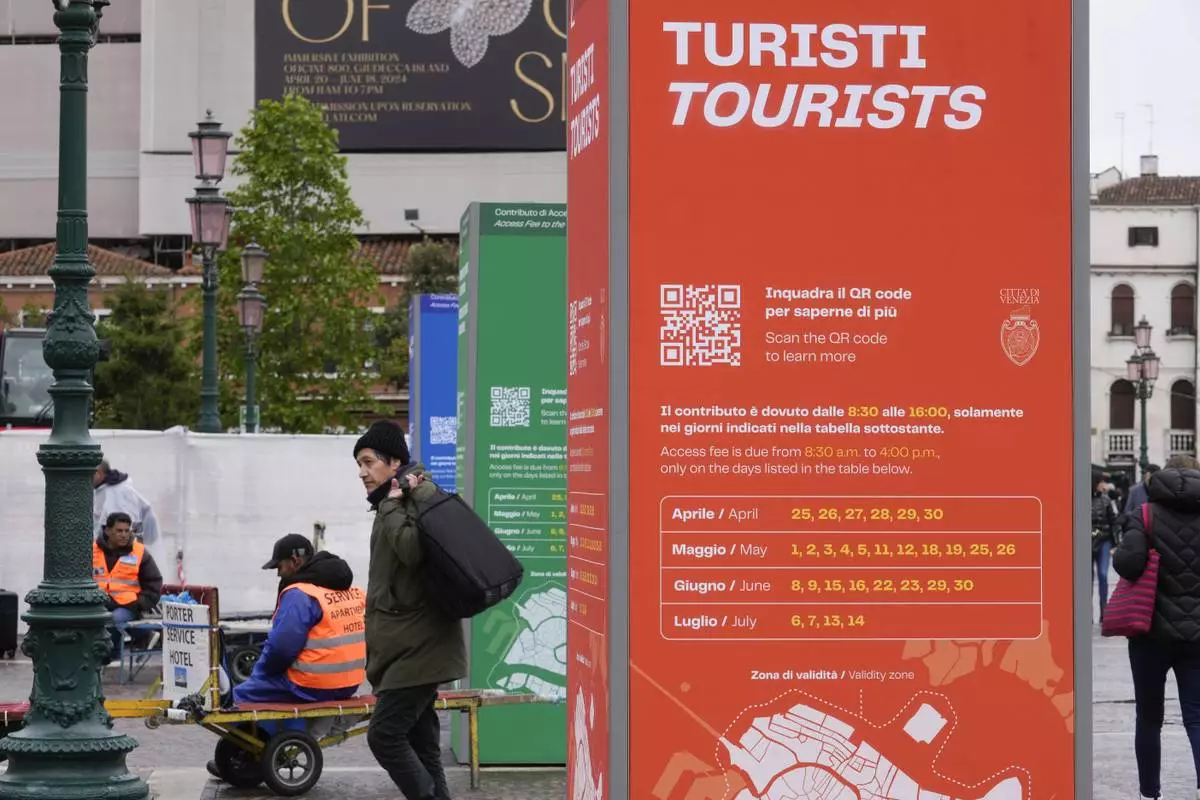
Tourist information boards are seen outside the main train station in Venice, Italy, Wednesday, April 24, 2024. The lagoon city of Venice begins a pilot program Thursday, April 25, 2024 to charge daytrippers a 5 euro entry fee that authorities hope will discourage tourists from arriving on peak days. Officials expect some 10,000 people will pay the fee to access the city on the first day, downloading a QR code to prove their payment. (AP Photo/Luca Bruno)
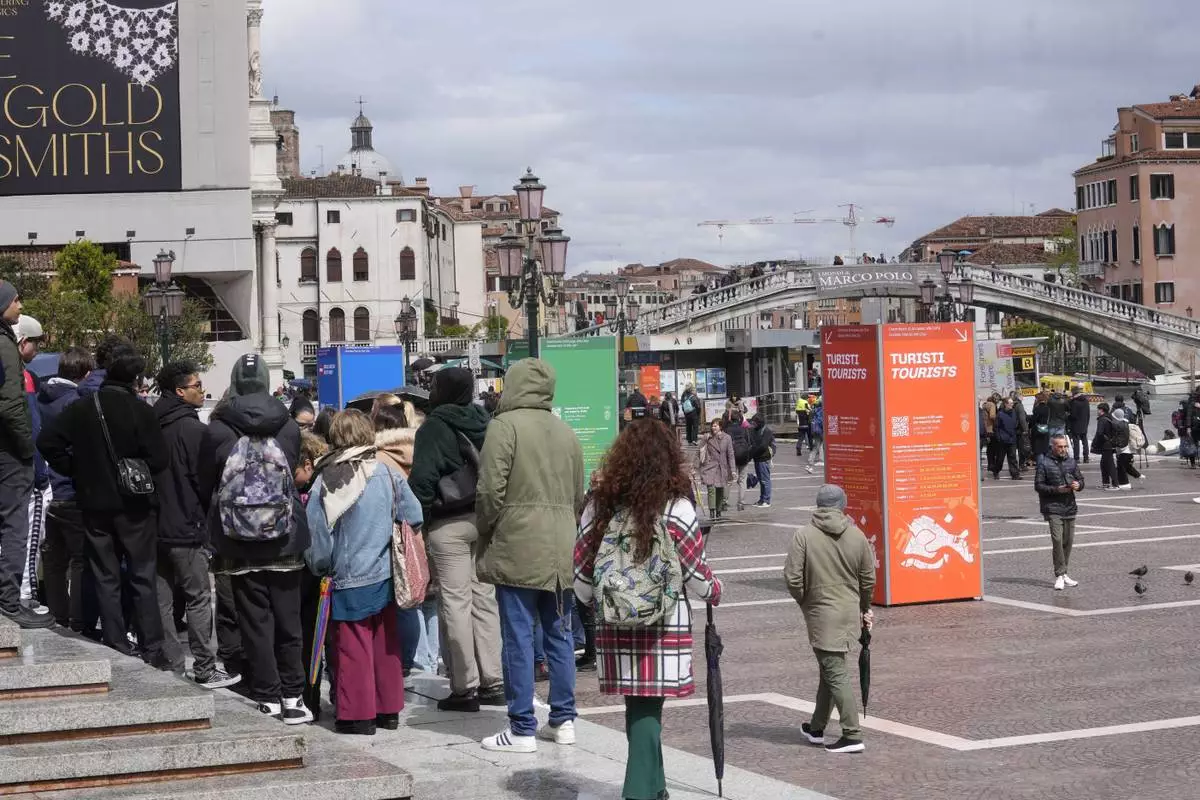
Tourists arrive outside the main train station in Venice, Italy, Wednesday, April 24, 2024. The lagoon city of Venice begins a pilot program Thursday, April 25, 2024 to charge daytrippers a 5 euro entry fee that authorities hope will discourage tourists from arriving on peak days. Officials expect some 10,000 people will pay the fee to access the city on the first day, downloading a QR code to prove their payment. (AP Photo/Luca Bruno)




























